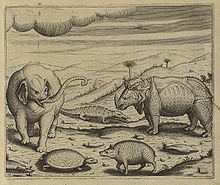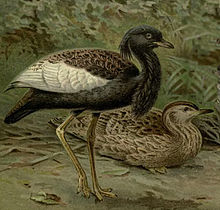Orang National Park
| Orang National Park | |
|---|---|
Darrang and Sonitpur district, Assam, India | |
| Coordinates | 26°33′25″N 92°19′40″E / 26.5568148°N 92.3279016°E |
| Area | 78.81 km2 (30.43 sq mi) |
| Established | 1985 |
| Governing body | Government of India, Government of Assam |
Orang National Park is a national park in
History
The park has a chequered history of habitation. Up to 1900, it was inhabited by the local tribes. On account of an epidemic disease, the tribal population abandoned the area. In 1919 the
Geography
The Orang National Park, encompassing an area of 78.81 square kilometres (30.43 sq mi), lies on the north bank of the Brahmaputra River, delimited between 26°28′59″N 92°15′58″E / 26.483°N 92.266°E and 26°39′58″N 92°27′00″E / 26.666°N 92.45°E within the districts of Darrang and Sonitpur. Pachnoi river, Belsiri river and
The park is thus formed of alluvial
- deciduous forest-15.85 square kilometres (6.12 sq mi)
- Eastern seasonal swamp forest - 3.28 square kilometres (1.27 sq mi)
- Eastern wet alluvial grassland- 8.33 square kilometres (3.22 sq mi)
- Savannahgrassland- 18.17 square kilometres (7.02 sq mi)
- Degraded grassland- 10.36 square kilometres (4.00 sq mi)
- Bodies of water- 6.13 square kilometres (2.37 sq mi)
- Moist sandy area-2.66 square kilometres (1.03 sq mi)
- Dry sandy area -4.02 square kilometres (1.55 sq mi)
It has a fairly flat terrain tending north to south with a gentle slope. The elevation in the park varies from 45 metres (148 ft) to 70 metres (230 ft). It is bounded on its south and east by islands and spill channels of the river. The flat
Climate
The climate in the park comprises three seasons, namely summer,
Fauna
Mammalian species

Orang park contains significant breeding populations of several mammalian species. Apart from the
Some important species of the critically endangered and endangered category are the following.The
The Bengal tiger (Panthera tigris tigris) population was estimated to comprise 19 individuals in 2000, based on pug marks.[2]
Fishes
More than 50 species of fish have been recorded in the river and channels flowing through the park.
Avian fauna

Due to its variety of birdlife, including endangered and rare species, the park is listed as one of
Forty-seven species from the bird
The Bengal florican (Houbaropsis bengalensis) is listed as Critically Endangered on the IUCN Red List and is one of the flagship species of the park. A population of 30−40 individuals was recorded in the park by the Bombay Natural History Society (BNHS) in 1990; this was the second highest concentration of the species, globally. As of 2023[update] Orang has in excess of one per cent of the world's total population of the bird.[7][10][11]
Reptiles
Seven species of
Flora
The park is rich in vegetation of forests, natural forest, grasses, and aquatic and non-aquatic plants. The forest species found are:
Threats and conservation
From 1991, there was a serious threat to the survival of the park and its wild animals due to intense anthropogenic pressure— including illegal occupation by immigrants from the neighbouring country[citation needed] and encroachment from agriculture and forest resource harvesting by local populations dependent for their livelihoods on such practices[13] —and by insurgency. The threats were identified as due to poaching, inadequate manpower for patrolling and security, wide river channels, inadequate infrastructure facilities and hardly any community awareness and participation in conservation.
Poaching for wild animals became very serious, particularly of the great Indian rhinoceros whose population reduced to 48 vis-à-vis 97 rhinoceros in 1991. By undertaking anti poaching measures, their number had increased to 68 in 2006-2007 but poaching and killing of rhinos are still reported. To check this continued poaching, a "Coordination Committee" with top officials of Darrang, Sonitpur and the
Since royal Bengal tigers are also under serious threat in the park, a conservation programme sponsored by WAZA (
References
- ^ "Flap over renaming Orang". Indian jungles.com. 22 August 2005. Archived from the original on 12 March 2010. Retrieved 9 November 2009.
- ^ a b c d Ahmed, M. F.; Das, C.; Das, D.; Sarma, P.; Deka, J.; Talukdar, B.N.; Momin, S.; Talukdar, B. K. (2009). Ecological Monitoring of Tigers in Orang National Park, Assam, India. First Year (2008-09) (PDF) (Report). Guwahati: Aaranyak.
- ^ a b c "Orang National Park". Archived from the original on 25 January 2010. Retrieved 9 November 2009.
- ^ a b c d e "Orang National Park". Retrieved 8 November 2009.
- ^ a b c d "Rajiv Gandhi Orang National Park". Department of Environment & Forests Government of Assam. Archived from the original on 6 December 2010. Retrieved 9 November 2009.
- .
- ^ a b BirdLife International (2023). "Important Bird Areas factsheet: Orang National Park". BirdLife Data Zone. Important Bird and Biodiversity Areas (IBAs). Retrieved 17 February 2023.
- ^ a b c "Spatial modeling and preparation of decision support system for conservation of biological diversity in Orang National Park, Assam, India" (PDF). Retrieved 8 November 2009.
- ^ "Best of wildlife, Assam". Archived from the original on 3 November 2009. Retrieved 9 November 2009.
- ^ Rahmani, Asad R.; Narayan, G.; Rosalind, L.; Sankaran, R. "Status of the Bengal Florican in India". In Bombay Natural History Society (ed.). Status and Ecology of the Lesser and Bengal Floricans, with reports on Jerdon's Courser and Mountain Quail. Bombay: BNHS. pp. 55–82.
- ^ Government of the Republic of India (25 September 2019). Proposal for the inclusion of the Bengal Florican (Houbaropsis bengalensis bengalensis) in APPENDIX I of the Convention on Migratory Species (PDF). 13th Meeting of the Conference of the Parties to the Convention on Migratory Species (CMS), 17−22 February 2020. Gandhinagar, India: United Nations Environment Programme (UNEP). UNEP/CMS/COP13/Doc. 27.1.5. Archived from the original (PDF) on 20 January 2022.
- . Retrieved 17 February 2023.
- ^ Biswajit, Chakdar; Jathar, Girish Avinash; Das, Jyoti P (2021), "A Survival Blueprint for the conservation and management of Bengal Florican Houbaropsis bengalensis in India", An output from the EDGE of Existence Programme fellowship, Zoological Society of London (PDF), Mumbai: Bombay Natural History Society
- ^ a b "Poachers posing threat to Orang National Park". International Rhino Foundation. 13 September 2009. Archived from the original on 19 December 2010. Retrieved 9 November 2009.
- ^ "Rhinos make healthy comeback at Orang National Park". Northeast Watch. Archived from the original on 23 August 2011. Retrieved 9 November 2009.
- ^ "Indian Rhino Vision 2020". The World Association of Zoos and Aquariums (WAZA). Retrieved 26 July 2016.
- ^ "Animals:Tigers". Ecological Monitoring of Wild Tigers in Orang National Park, Assam, India. Seaworld.org. Retrieved 8 November 2009.
